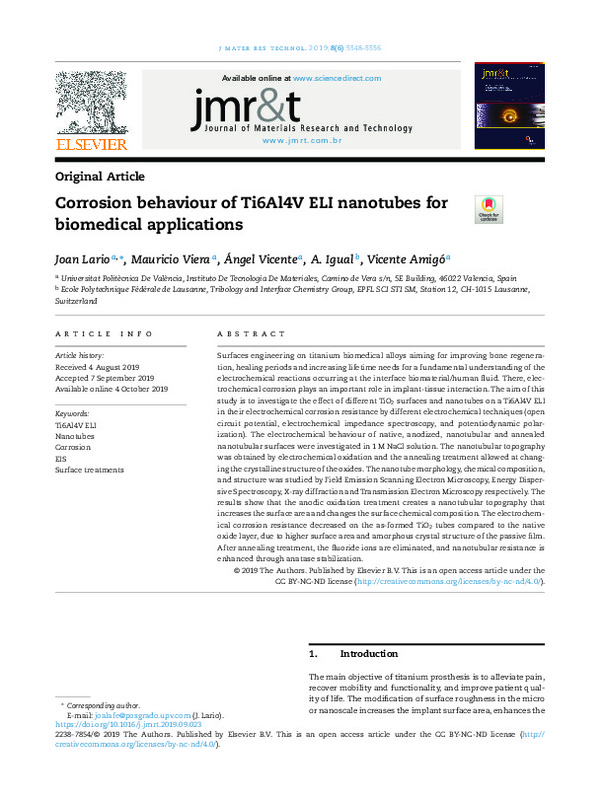JavaScript is disabled for your browser. Some features of this site may not work without it.
Buscar en RiuNet
Listar
Mi cuenta
Estadísticas
Ayuda RiuNet
Admin. UPV
Corrosion behaviour of Ti6Al4V ELI nanotubes for biomedical applications
Mostrar el registro sencillo del ítem
Ficheros en el ítem
| dc.contributor.author | Lario, Joan
|
es_ES |
| dc.contributor.author | Viera, Mauricio
|
es_ES |
| dc.contributor.author | Vicente-Escuder, Ángel
|
es_ES |
| dc.contributor.author | Igual Muñoz, Anna Neus
|
es_ES |
| dc.contributor.author | Amigó, Vicente
|
es_ES |
| dc.date.accessioned | 2021-01-12T21:02:57Z | |
| dc.date.available | 2021-01-12T21:02:57Z | |
| dc.date.issued | 2019-12 | es_ES |
| dc.identifier.issn | 2238-7854 | es_ES |
| dc.identifier.uri | http://hdl.handle.net/10251/158845 | |
| dc.description.abstract | [EN] Surfaces engineering on titanium biomedical alloys aiming for improving bone regeneration, healing periods and increasing lifetime needs fora fundamental understanding of the electrochemical reactions occurring at the interface biomaterial/human fluid. There, electrochemical corrosion plays an important role in implant-tissue interaction. The aim of this study is to investigate the effect of different TiO2 surfaces and nanotubes on a Ti6Al4V ELI in their electrochemical corrosion resistance by different electrochemical techniques (open circuit potential, electrochemical impedance spectroscopy, and potentiodynamic polarization). The electrochemical behaviour of native, anodized, nanotubular and annealed nanotubular surfaces were investigated in 1 M NaCl solution. The nanotubular topography was obtained by electrochemical oxidation and the annealing treatment allowed at changing the crystalline structure of the oxides. The nanotube morphology, chemical composition, and structure was studied by Field Emission Scanning Electron Microscopy, Energy Dispersive Spectroscopy, X-ray diffraction and Transmission Electron Microscopy respectively. The results show that the anodic oxidation treatment creates a nanotubular topography that increases the surface area and changes the surface chemical composition. The electrochemical corrosion resistance decreased on the as-formed TiO2 tubes compared to the native oxide layer, due to higher surface area and amorphous crystal structure of the passive film. After annealing treatment, the fluoride ions are eliminated, and nanotubular resistance is enhanced through anatase stabilization. | es_ES |
| dc.description.sponsorship | The authors wish to thank the Spanish Ministry of Economy and Competitiveness for the financial support of Research Project MAT2014-53764-C3-1-R, the Generalitat Valenciana for support through PROMETEO 2016/040, and the European Commission via FEDER funds to purchase equipment for research purposes and the Microscopy Service at the Valencia Polytechnic University. Thanks to Alba Dalmau and Javier Navarro Laboulais from Instituto de Seguridad Industrial y Medio Ambiente, Valencia Polytechnic University for the technical assistance with preparation of the electrochemical tests. Thanks to Irene Llorente and Jose Antonio Jimenez from CENIM/CSIC for the technical assistance with XRD characterization. | es_ES |
| dc.language | Inglés | es_ES |
| dc.publisher | Elsevier | es_ES |
| dc.relation.ispartof | Journal of Materials Research and Technology | es_ES |
| dc.rights | Reconocimiento - No comercial - Sin obra derivada (by-nc-nd) | es_ES |
| dc.subject | Ti6Al4V ELI | es_ES |
| dc.subject | Nanotubes | es_ES |
| dc.subject | Corrosion | es_ES |
| dc.subject | EIS | es_ES |
| dc.subject | Surface treatments | es_ES |
| dc.subject.classification | INGENIERIA QUIMICA | es_ES |
| dc.subject.classification | ORGANIZACION DE EMPRESAS | es_ES |
| dc.subject.classification | CIENCIA DE LOS MATERIALES E INGENIERIA METALURGICA | es_ES |
| dc.title | Corrosion behaviour of Ti6Al4V ELI nanotubes for biomedical applications | es_ES |
| dc.type | Artículo | es_ES |
| dc.identifier.doi | 10.1016/j.jmrt.2019.09.023 | es_ES |
| dc.relation.projectID | info:eu-repo/grantAgreement/MINECO//MAT2014-53764-C3-1-R/ES/ESTUDIO DEL COMPORTAMIENTO TRIBO-ELECTROQUIMICO EN NUEVAS ALEACIONES DE TITANIO DE BAJO MODULO Y SU MODIFICACION SUPERFICIAL PARA APLICACIONES BIOMEDICAS./ | es_ES |
| dc.relation.projectID | info:eu-repo/grantAgreement/GVA//PROMETEO%2F2016%2F040/ES/DESARROLLO DE ALEACIONES DE TITANIO Y MATERIALES CERAMICOS AVANZADOS PARA APLICACIONES BIOMEDICAS/ | es_ES |
| dc.rights.accessRights | Abierto | es_ES |
| dc.contributor.affiliation | Universitat Politècnica de València. Departamento de Ingeniería Química y Nuclear - Departament d'Enginyeria Química i Nuclear | es_ES |
| dc.contributor.affiliation | Universitat Politècnica de València. Instituto de Tecnología de Materiales - Institut de Tecnologia de Materials | es_ES |
| dc.contributor.affiliation | Universitat Politècnica de València. Departamento de Organización de Empresas - Departament d'Organització d'Empreses | es_ES |
| dc.contributor.affiliation | Universitat Politècnica de València. Departamento de Ingeniería Mecánica y de Materiales - Departament d'Enginyeria Mecànica i de Materials | es_ES |
| dc.description.bibliographicCitation | Lario, J.; Viera, M.; Vicente-Escuder, Á.; Igual Muñoz, AN.; Amigó, V. (2019). Corrosion behaviour of Ti6Al4V ELI nanotubes for biomedical applications. Journal of Materials Research and Technology. 8(6):5548-5556. https://doi.org/10.1016/j.jmrt.2019.09.023 | es_ES |
| dc.description.accrualMethod | S | es_ES |
| dc.relation.publisherversion | https://doi.org/10.1016/j.jmrt.2019.09.023 | es_ES |
| dc.description.upvformatpinicio | 5548 | es_ES |
| dc.description.upvformatpfin | 5556 | es_ES |
| dc.type.version | info:eu-repo/semantics/publishedVersion | es_ES |
| dc.description.volume | 8 | es_ES |
| dc.description.issue | 6 | es_ES |
| dc.relation.pasarela | S\399283 | es_ES |
| dc.contributor.funder | Generalitat Valenciana | es_ES |
| dc.contributor.funder | Ministerio de Economía y Empresa | es_ES |
| dc.contributor.funder | European Regional Development Fund | es_ES |








